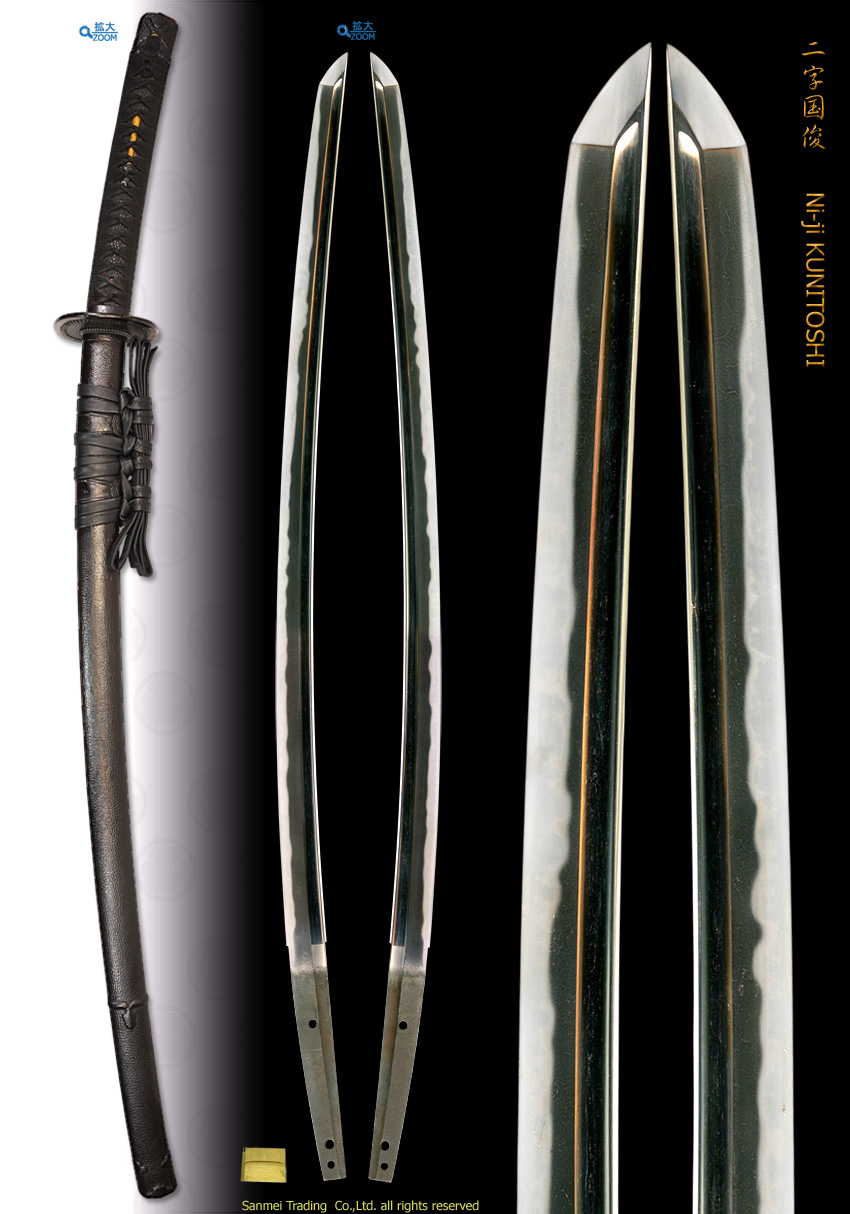with) Black wrinkles leather wrap Tachi Koshirae
NBTHK(Tokubetsu Hozon Tousougu)
Length of cutting edge 63.8cm Curvature 1.5cm Width of base 28.7mm Width of Yokote 18.5mm Thickness of base 6.7mm Length of Kissaki 26.0mm Length of Nakago 17.1cm
Carving (Horimono): Full-up Bo-hi grooves chiselled away onto Nakago
Forging(Hada): Forging is fine Ko-Itame hada with an indication of sparkling Ji-Nie granules attaches on surface and darkish lines in different state of carbonate so called "CHIKEI" wells out. Entire Hiraji emits sparkling reflection of irregular Nie-trend Midare-Utsuri.
Temper(Hamon): Hamon is based on tassel shape Choji-midare and angled Gunome in rather on stronger side fine Nie granules. The abundant quenching activities such as Ashi, YOU, short lines of Sunagashi or long lines of Kinsen appear along quenching boundary area that gives off vividly bright light. Upper the blade, some isolated Muneyaki appears.
Temper of tip(Boshi): Temper of Boshi forms undulating Notare then small circle turns back.
Tang(Nakago): The tang is Ō-suriage, substantially shortened unsigned. Yasurime is Horizontal KIRI. KIRI horizontal bottom heel. Three peg Mekugina punches.
KUNITOSHI 国俊 in 2 character is called Niji KUNITOSHI 二字国俊, reportedly a legitimate son of KUNIYUKI 国行, played a major role in Kyoto and exclusively worked not only for the Imperial families but also to meet with increasing demand from powerful Samurai warlord.
Workmanship between Niji KUNITOSHI 二字国俊 and next generation Rai KUNITOSHI 来国俊 differs in essence. Niji KUNITOSHI 二字国俊 forms valiant construction with flamboyant clove outline, rather on stronger side Nie-deki generating sparkling Nie-Utsuri reflection to bear parallel resemblance to Fukuoka Ichimonji works whereas Rai KUNITOSHI 来国俊 usually forms slender figure with highly defined curved near the base with gentle Suguha Hamon created in archaic style moving toward specialization in demand from Imperial families.
This Kanata, although substantially shortened Ō-suriage to be unsigned, Forging is fine Ko-Itame with splendidly bright Ji-Nie forms Midare-utsuri reflection as well as the most flamboyant Choji-ha gives off the finest marvelous splash.
Although there are some indication of an old puncture in the interior of temper and upper back ridge of Mune, those are well eliminated by skilled polish. This Katana is 35th JUYO Token awarded as one of the best works of Niji KUNITOSHI 二字国俊.
with) Black wrinkles leather wrap Tachi Koshirae (Tokubetsu Hozon Tousougu)
(click HERE for Taichi Koshirae in front, HERE for the other side and HERE for each fitting)
- All fittings are leather wrap, unsigned
- Menuki : Sanko-ken design
- Tsuba : Meshwork design leather wrap unsigned
- Tsuka : Black lacquered rayskin, black silk cord Moro-hineri style lozenge wrap
Gold foiled Tachi Habaki for Tachi Koshirae mount
preserved in Shirasaya plain wood mounting
Old good polish/Condition scale: excellent - very good (using a scale of mint-excellent-very good-good-fair-poor).
reference data :
JUYO TOUKEN ZUROKU, Japanese Sword Preservation Sociery
Touken/Tousougu owed byTokugawa Art Museum, Tokugawa Art Museum, Otsuka Kougeisha, 1998




